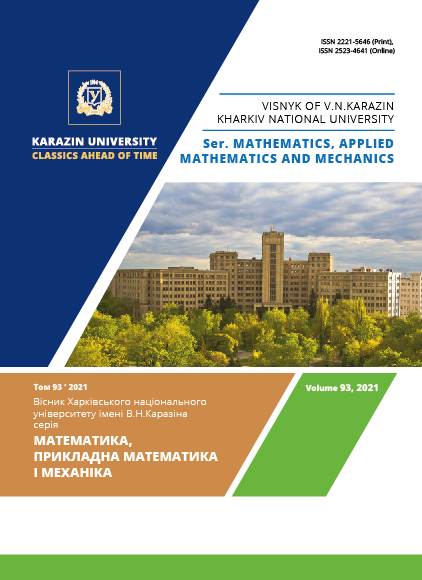Implicit linear difference equations over a non-Archi-medean ring
Abstract
Over any field an implicit linear difference equation one can reduce to the usual explicit one, which has infinitely many solutions ~ one for each initial value. It is interesting to consider an implicit difference equation over any ring, because the case of implicit equation over a ring is a significantly different from the case of explicit one. The previous results on the difference equations over rings mostly concern to the ring of integers and to the low order equations. In the present article the high order implicit difference equations over some other classes of rings, particularly, ring of polynomials, are studied.
To study the difference equation over the ring of integer the idea of considering p-adic integers ~ the completion of the ring of integers with respect to the non-Archimedean p-adic valuation was useful. To find a solution of such an equation over the ring of polynomials it is naturally to consider the same construction for this ring: the ring of formal power series is a completion of the ring of polynomials with respect to a non-Archimedean valuation.
The ring of formal power series and the ring of p-adic integers both are the particular cases of the valuation rings with respect to the non-Archimedean valuations of some fields: field of Laurent series and field of p-adic rational numbers respectively. In this article the implicit linear difference equation over a valuation ring of an arbitrary field with the characteristic zero and non-Archimedean valuation are studied. The sufficient conditions for the uniqueness and existence of a solution are formulated. The explicit formula for the unique solution is given, it has a form of sum of the series, converging with respect to the non-Archimedean valuation.
Difference equation corresponds to an infinite system of linear equations. It is proved that in a case the implicit difference equation has a unique solution, it can be found using Cramer rules.
Also in the article some results facilitating the finding the polynomial solution of the equation are given.
Downloads
References
V. A. Gerasimov, S. L. Gefter, A. B. Goncharuk. Application of the p-Adic Topology on ℤ to the Problem of Finding Solutions in Integers of an Implicit Linear Difference Equation, Journal of Mathematical Sciences, ~ 2018. ~ 235. ~ P. 256-261. https://doi.org/10.1007/s10958-018-4072-x
S. Gefter, A. Goncharuk. Generalized backward shift operators on the ring ℤ[[x]], Cramer's rule for infinite linear systems, and p-adic integers. In: A. Bӧttcher, D. Potts, P. Stollmann, D. Wenzel (eds) The Diversity and linebreak Beauty of Applied Operator Theory. Operator Theory: Advances and Applications, Vol. 268. Birkhӓuser, Cham., ~ 2018. ~ P. 247-259. https://doi.org/10.1007/978-3-319-75996-8_13
S. L. Gefter, V. V. Martseniuk, A. B. Goncharuk, A. L. Piven'. Analogue of the Cramer Rule for an Implicit Linear Second Order Difference Equation Over the Ring of Integers, Journal of Mathematical Sciences, ~ 2020. ~ 244. ~ P. 601-607. https://doi.org/10.1007/s10958-019-04635-w
I. R. Shafarevich. Basic Notions of Algebra. In: A. I. Kostrikin, I. R. Shafarevich (eds) Algebra I. Encyclopaedia of Mathematical Sciences. 1990. Springer, Berlin, Heidelberg, 258~p. https://doi.org/10.1007/978-3-662-39643-8_1
S. Lang. Algebra. 2002. Springer-Verlag, New York, XV+918~p. https://doi.org/10.1007/978-1-4613-0041-0
C. Perez-Garcia, W. H. Schikhof. Locally Convex Spaces over Non-Archimedean Valued Fields. 2010. Cambridge University Press, 472~p. https://doi.org/10.1017/CBO9780511729959
A. I. Derevianko, S. L. Gefter. Rational Solutions of the Simplest Linear Inhomogeneous Difference Equations, Theoretical and Applied Aspects of Cybernetics, Proceedings of the 5th International Scientific Conference of Students and Young Scientists. 2015. Bukrek, Kyiv. P. 117-122.
Copyright (c) 2021 Anna Goncharuk

This work is licensed under a Creative Commons Attribution-NonCommercial-NoDerivatives 4.0 International License.
The copyright holder is the author.
Authors who publish with this journal agree to the following terms:
1. Authors retain copyright and grant the journal right of first publication with the work simultaneously licensed under a Creative Commons Attribution License that allows others to share the work with an acknowledgement of the work's authorship and initial publication in this journal. (Attribution-Noncommercial-No Derivative Works licence).
2. Authors are able to enter into separate, additional contractual arrangements for the non-exclusive distribution of the journal's published version of the work (e.g., post it to an institutional repository or publish it in a book), with an acknowledgement of its initial publication in this journal.
3. Authors are permitted and encouraged to post their work online (e.g., in institutional repositories or on their website) prior to and during the submission process, as it can lead to productive exchanges, as well as earlier and greater citation of published work (see The Effect of Open Access).




